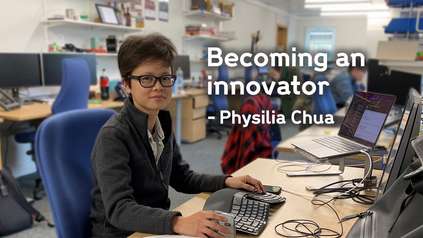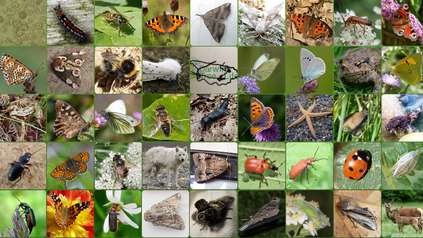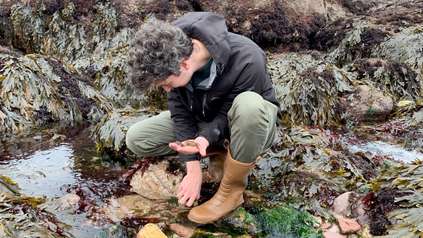Following insect footprints to improve crop resilience and monitor pollinator biodiversity
Bees and other insects leave behind tiny ‘footprints’ of environmental DNA on plants each time they visit, giving researchers a way of tracking where insects have been, and offering clues on how to help them flourish.
A team of researchers, including the Wellcome Sanger Institute and led by the University of Copenhagen, have used these DNA footprints as a non-invasive way to collect information on insect biodiversity, giving new insight into how to boost pollination and protect insect biodiversity and crops against threats such as climate change.
The new study, published today (6 December 2022) in Environmental DNA, is the first time DNA footprints have been used alongside visual observations to track the kind of insect visitors to crops, helping to see if there are any pests and informing new ways to encourage beneficial insects.
For example, the team uncovered the importance of wild non-bee pollinators that have previously been underestimated in their impact, along with identifying multiple pest species. These findings can inform new management strategies based on the specific insects visiting an orchard or crop.
This study is part of the BEESPOKE* project which is a collaboration between a range of partners including the University of Copenhagen, policy makers, and research institutes, from six North Sea Region countries. The aim of the project is to develop new products and approaches to increase the diversity of insect pollinators and crop yields.
Crops require bees and other pollinators to move pollen from one flower to another, allowing the plant to produce seeds and fruit.
Threats such as pollinator decline due to pesticides and climate change can impact crop yield and quality, directly affecting many people’s livelihoods and food availability in general.
Having an environment that’s rich in biodiversity, with a variety of beneficial pollinators can help protect crops against these threats. Therefore, knowing what insects are visiting crops, how they work as a community and highlighting pest species is important to inform management techniques.
Currently, the insect community in an area is tracked by visual observation. However, the presence of observers can alter insect behaviour. Visual observation is also extremely time consuming and can miss certain populations of insects, especially those that are nocturnal as most observations are carried out during the day when there is enough light.
Bees and other insects leave behind DNA footprints, also known as environmental DNA, or eDNA, which can be analysed to reveal information on the type of insect visitors to an area.
In this new study, which is part of the BEESPOKE* project, researchers compared the variety of insects detected using this genetic method with visual observation in four apple orchards in Denmark, all of which ranged between 40m to 100m wide — seven to 20 rows of trees.
The eDNA was extracted from apple flowers, which is an important step in the identification of footprints from insect flower visitors**.
This is the first study that has compared the use of DNA footprints to visual insect monitoring and they found that analysing the genetic footprints led to a more comprehensive view of insect biodiversity, with more insect visitors identified.
The team was also able to show the importance of non-bee insects as pollinators, such as flies (Diptera). Flies’ presence and their impact on pollination in apple orchards have been underestimated previously. The researchers also highlighted two species of moths that feed on apple trees and can result in high crop losses.
“A high level of insect biodiversity protects an environment against certain threats, therefore monitoring these levels is necessary to see if and when intervention is needed. Our study showed that eDNA adds a lot of value when compared against visual collecting techniques. This isn’t to say that visual census is unnecessary, in fact having an understanding of the insects in an area from observational techniques can provide prior knowledge of the specific community being assessed, making it a valuable complementary tool.”
Nerea Gamonal, first author from the University of Copenhagen, Denmark
“Our study details the techniques used to extract environmental DNA left on apple flowers, and we hope that it encourages the use of eDNA in future research.”
Didde Hedegaard Sørensen, Laboratory Technician and an author from the University of Copenhagen, Denmark
“The exciting thing about this study is that it can have an immediate, real-world impact on agricultural systems. The results and techniques in our study can be used to inform management practices such as the type of pest control used, the orchard design, and what additional floral resources surround the crops. In Denmark, our close collaboration with HortiAdvice and the BEESPOKE project partners really supports this effort. We have sown highly diverse native perennial flower mixes in the four farm sites. These mixes can support pollinators, and with more knowledge of the pollinators in apples and other crops, we can begin to provide tailor-made flower mixes for individual crops, and improve our knowledge on the value of the surrounding landscape for wild pollinators.”
Professor Lene Sigsgaard, co-senior author from the University of Copenhagen
“Our results can assist farmers in managing their crops against the rising threats of reduced pollinators. Environmental DNA can be used to investigate the biodiversity in agricultural landscapes beyond apple orchards, making it a fast and non-invasive way to gain more knowledge about the world around us. Understanding how we can work with the environment, such as improving the surrounding landscape to attract beneficial insects, can help cross-pollination and lead to crops becoming more resilient against climate change. We hope this research can help our society become as environmentally friendly as possible, protecting our biodiversity, food sources and livelihoods.”
Dr Physilia Chua, co-senior author from the Wellcome Sanger Institute
More information
*This study is part of the project Beespoke, funded by the EU Interreg Northsea programme, of which University of Copenhagen is a partner.
The BEESPOKE project brings together a wide range of partners from policy makers, research institutes, advisory and end users from 6 North Sea Region (NSR) countries to develop new products and approaches to increase the diversity of insect pollinators and crop yields by 10%.
Insect pollination is worth €15 Billion in the EU but wild pollinators are declining because of loss in flower-rich habitats. In response the EU adopted a pollinator initiative in 2018. The NSR is one of the most productive agricultural areas but pollinators are in decline across the region. The overall objective is to increase levels of pollinators and crop pollination at local and landscape scales by providing land managers and policy makers with new expertise, tools and financial knowledge to create more sustainable and resilient agroecosystems.
Link to the Interreg NS Beespoke project: https://northsearegion.eu/beespoke/project-summary/
**This was performed by Laboratory Technician, Didde Hedegaard Sørensen, at the University of Copenhagen.
Publication:
N. Gomez, D. Sørensen, P. Chua, L. Sigsgaard. (2022) Assessing flower-visiting arthropod diversity in apple orchards through environmental DNA flower metabarcoding and visual census. Environmental DNA. DOI: 10.1002/edn3.362
Funding:
This research was part of the H2020 MSCA-ITN-ETN Plant.ID network. The study was funded as part of the European Union Horizon 2020 research and innovation programme under grant agreement No. 765000. The BEESPOKE project is funded by the Interreg VB North Sea Region programme. More information can be found on the full publication.





